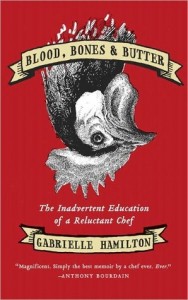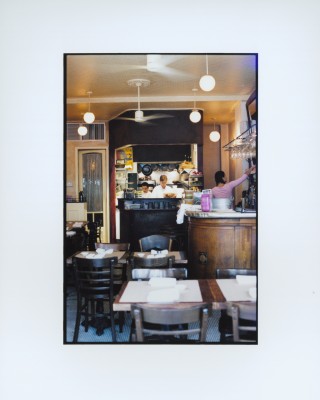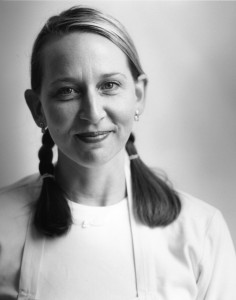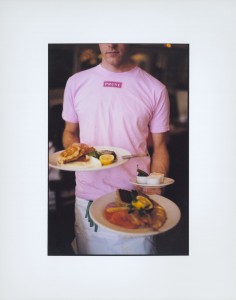Read Part 1 of this interview with Gabrielle Hamilton, NYC restaurateur and author of the memoir Bread, Bones & Butter. Questions in Parts 1 and 2 were selected and edited from those submitted by students in my course Memories into Story I, offered through University of Toronto’s School of Continuing Studies.
“… there is a story to tell and I need to tell it well. This is as true with a coq au vin as it is with an essay.”
Once upon a time I owned a restaurant, and your stories about your days there rang true down to my nerve-racked bones. I felt a pace in the writing about those days that was different, wonderfully so, fast, and frenetic, and then as your relationship developed and your family life expanded the flow of the writing changed. If I’m even right, was this intentional on your part?
I hope everything I said [see Part 1] about my teacher Peter Brodie in high school answers this question! Yes. Every single word was intentional, the lengths of sentences were intentional, the varying fluidity, lyricism, and wordiness of sentences was used on purpose as was the employment of staccato, terse, and muscular sentences. Different tools for different jobs. Still, I am aware of how much of a beginner I am! Someday I want to hold the reins of that team of horses with impeccable slack-tense form.
I am amazed at how you have so successfully managed not only to own and operate a successful restaurant but do so while raising children … AND write, again successfully. How do you arrange the time for yourself to focus on writing?
It was a particularly gruesome period, and we all got hurt — my restaurant, my kids, and not least of all myself. I wrote while standing on the line in my apron between dinner pushes — often with a Sharpie on a piece of torn brown butcher paper that we use to set the tables in the dining room. I wrote while nursing in the middle of the night, with a sleeping infant on either side of me and an Itty Bitty Book Light clamped to my notebook. I did not sleep more than four hours a night for some four years, and sometimes not all of those hours were consecutive. Needless to say, I was ragged, shrill, and profoundly out of whack. I would never have done it that way if I’d known a different path. But each thing in front of me was non-negotiable: my children, my restaurant, and my book contract. I had already been given the money! I believe this insane scenario describes the lives of a billion women, rich and poor, across cultures — we just have so much non-negotiable shit to do and we just do it, somehow. I will say, though, that I personally have never figured out how to make writing a non-negotiable practice if it isn’t attached to a contract and a deadline.
I loved your mother in this book, although I understand why you may have had issues with her. You grew up composting and recycling when it was still a new concept and she gave you ratatouille sandwiches instead of Cheez Whiz. She was ahead of her time. Was it difficult to write about her? If she read your book, did she comment?
 I am so glad to hear that, as I, too, loved my mother in this book. She was and is a formidable woman with an excellent sense of humour! She wrote and said she was proud of the book, proud of me, that she admired me for the quality of the writing; she said she found it painful to read certain parts — the part about her in the early years in Vermont with her women friends and wearing blue jeans and the part where she is always forcing us to kiss her against our wishes. She said it was like having a very long visit with a person she hadn’t seen in a long time and she said she instantly recognized me and enjoyed the “visit” through the pages.
I am so glad to hear that, as I, too, loved my mother in this book. She was and is a formidable woman with an excellent sense of humour! She wrote and said she was proud of the book, proud of me, that she admired me for the quality of the writing; she said she found it painful to read certain parts — the part about her in the early years in Vermont with her women friends and wearing blue jeans and the part where she is always forcing us to kiss her against our wishes. She said it was like having a very long visit with a person she hadn’t seen in a long time and she said she instantly recognized me and enjoyed the “visit” through the pages.
I was not motivated to harm or overexpose anyone who appears in the book, and, accordingly, she received her galley pages well in advance of publishing. She asked me to change some of the French I had misspelled(!), and corrected a couple of details about our hometown. She also insisted it was not possible for her to have exhaled cigarette smoke when I was on her lap because she had quit smoking ages and ages before. I have a photograph of me sitting on her lap outside after dinner and she is smoking. This is the very problem of memoir and one I think we should get more comfortable with as it is inherent to the genre — I remembered Gunther with lions but they were tigers; she remembers not smoking but she was. I still think the stories work, either way.
There were technical obstacles to writing about her. I couldn’t remember exchanges with her in enough extended detail to write about her in a fully realized scene in childhood. She left when I was eleven. We stayed together until I was twelve. And then it was over. I could not for the life of me remember whole specific days or whole pages of dialogue from those early years and could only conjure her in bright, lucid, extremely detailed episodes. I had to include the Vermont trip to use as a vehicle for flashing back and knitting together those fragmented reminiscences of her because it was the only experience I had had of her in recent enough memory that I could reconstruct thoroughly.
But those were structural/technical difficulties, eventually ironed out. What I think might help you in your own memoir writing is to let you know that the hardest of the hard part of writing about my mother is that she said she found it painful to read about herself in Vermont but that she did not mention she found it painful to read about her thirteen-year-old daughter in a tube top doing coke. I mightily struggled to generously and humanely face the truth of her declared priorities.
To be unable to fully comprehend your subject (not made any damned easier, I have to say, when your own two young children sit in front of you as you write — one wiggling his loose tooth on the couch, the other at the kitchen counter picking at a ball of mozzarella) made my following my own rules about writing about people — What is he doing? And why is he doing it? — extremely challenging. And as has been pointed out by readers and critics alike, it was not done as well as I would have liked!
Did your husband have any concern over your writing about a marital fight in “Open House” — even though it was handled with such humour, and he came off as a hero — or was your crafting of it key to ensuring he was okay with it?
My husband is assured of and relies on the fact of my very willing adherence to the rules we spoke of earlier, regarding the privacy of the intimacies of marriage and family relationships, and my commitment to the complex and multidimensional, expansive tone one must take when describing one’s experience inside of that intimacy. It was imperative — and I strongly desired — to reveal him, ultimately, as darling and heroic. This doesn’t mean you write glossy, soft-focus, glib shit about marriage or else you will end up in the trashcan and no one will hire you to write because your work has no authenticity. I am aware that I set that barricade of privacy one ring closer to the core than most, but believe it or not, it is still very distant from the private home fire. He really enjoyed the piece and sent copies of it to all of his family in Italy!
Do you consider yourself a chef who writes, or a writer who also chefs?
I answer to both.
The title of your essay “Killing Dinner,” as well as phrasing in the first paragraph — “barehanded up through a chicken’s ass,” “sucking pigs, the same weight and size as a pet beagle,” “rabbits, even skinned, look exactly like bunnies” — seem calculated to appall. Did you intend this, and if so, why?
To the full but still clearly limited extent of my skills, yes, everything I put on the page is intentional and calculated, as all writing is. Killing an animal is appalling. Recognizing that your father dislikes you is appalling. I hoped to convey some of that.
The essay “The Lamb Roast” starts and ends with wonderful descriptions of elaborate parties and the lamb roasts. This reader felt envious — till the middle about the breakup of the family. There is such a huge distance between the joy of the lamb roast and the vitality of the family, and the statement “By the time my parents might have realized that they’d abandoned us, we were not to be recovered.” Was this pivotal chapter in early drafts of your memoir, or did it come to you later?
The editors at The New Yorker magazine cut and pasted chunks from several later chapters and wedged them into the opening, lamb roast chapter. In the book, the chapters build and build in a more linear and chronological fashion and you don’t get to the breakup of the family until several chapters deep. All of the chapters in the Blood section of the book, which describe my family and childhood and adolescence, were written early and had been in the manuscript from its earliest inceptions.
How many drafts do you usually write before showing your work to an editor and then to a publisher?
It’s not how many drafts but what condition the writing is in before I open it up to an editor. I don’t enjoy being told to clean my room when I can see perfectly well that my room is a mess. You want to be able to make a strong case for all of your choices on the page, which you can’t credibly do if you are submitting sloppy pages. This way, if I submit pretty tight and thoughtful and disciplined prose, I can enjoy the editor as a colleague, a second set of eyes, and not as an adversary or authority figure.
How do you determine if a subplot or a transition to another event/time might slow down the story or confuse the reader?
Read it out loud and see if you yourself are bored and distracted. Hope your editor will do the same, but understand that editors are very, very busy these days and don’t have as much time to spend on your manuscripts as you would wish.
How close was your final draft of Blood, Bones & Butter to the published version?
At that point, I just started writing and writing and looking at the page with everything I’ve ever learned about good writing and bad writing and forcing myself to have the discipline to adhere to it, just as I would have on the hot line at the restaurant. As I said in answer to an earlier question, by the time I was submitting my manuscript to my new editor at my new publishing house I was in full possession of the material, it was written to the best of my abilities, and I could argue for every word of it.
Are there parallels between how you approach cooking/creating in the kitchen and how you approach your writing process?
In both instances, there is a story to tell and I need to tell it well. This is as true with a coq au vin as it is with an essay. When I write I bring all of my decades in the hospitality industry with me and I aim to “serve” the reader as I would a guest in my restaurant. To make sure at every point that the readers have what they need, that they feel invisibly taken care of and well-fed and respectfully “served.” In cooking, I try to make sure the food follows the same rules as a writing project — that it has a clear and consistent voice, is grounded in its own idiom, is rigorously edited, and that it does not distract the diner by calling attention to me — the cook — rather than to the delicious food in front of them. So I would never, say, make coq au vin — rooster cooked in wine — with, you know, quail and balsamic syrup, with a foie gras ice cream cone that the server stands at your table telling you how the chef wishes you to eat. I would find a real rooster — one who has sired, and strutted, and pecked in the dirt — and good wine, and follow the rules of the dish, and tell the “story” of coq au vin, not the story of me me me.
Note from Allyson: The fall session of Memories into Story I, my introductory memoir writing course through University of Toronto SCS — begins September 22, 2014. Our guest author will be Catherine Gildiner, novelist and three-time memoirist (Too Close to the Falls, After the Falls, and Coming Ashore). For course details and to register, click here.



Wow – this is a fantastic interview. The questions were thought provoking and interesting, zeroing in on so many important aspects of writing craft, and Gabrielle Hamilton’s responses were generous and well crafted. I’m buying the book today! This part of your UofT course is such a bonus; I hope your students and the administration realize how fortunate they are to have your creative energy and connections to make these top-line interviews happen.